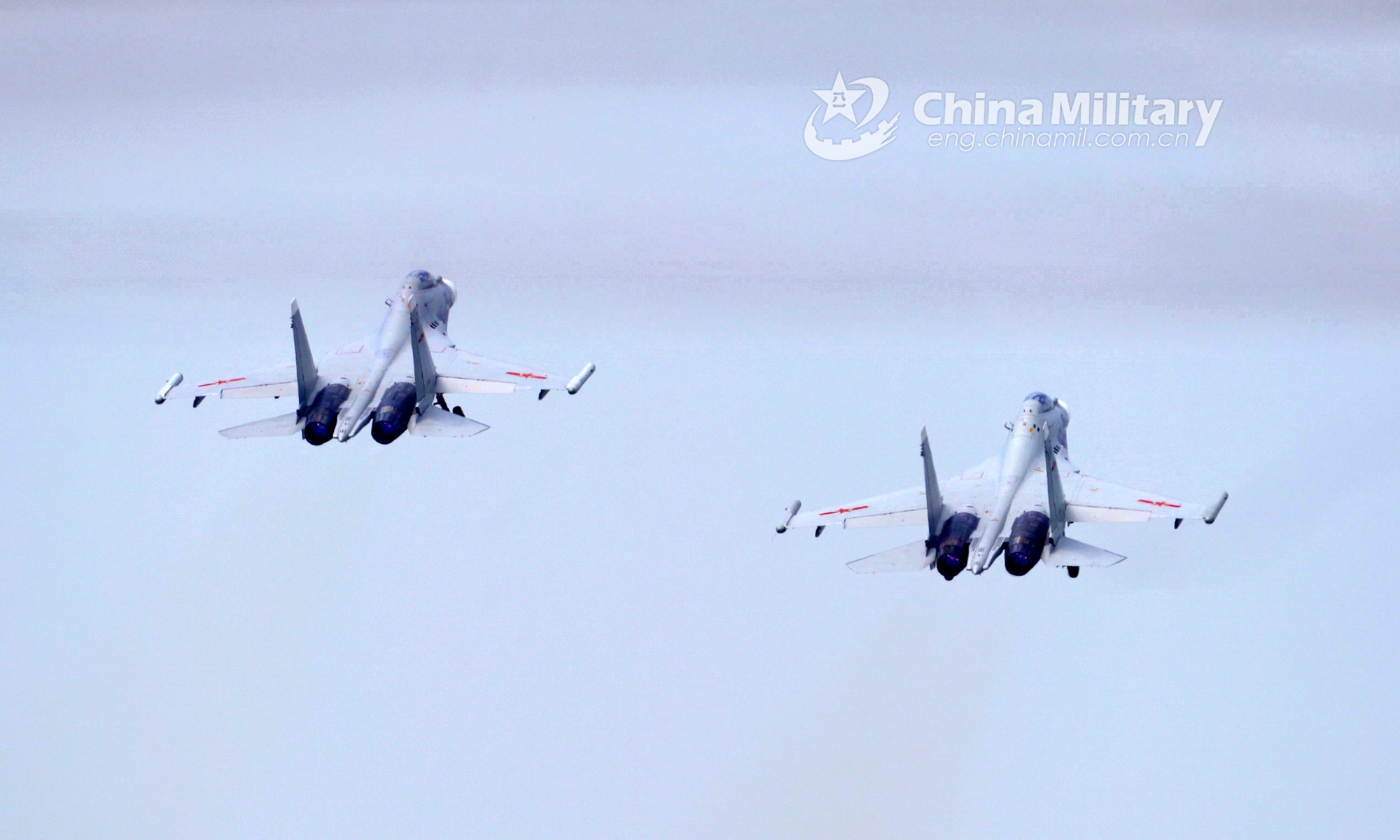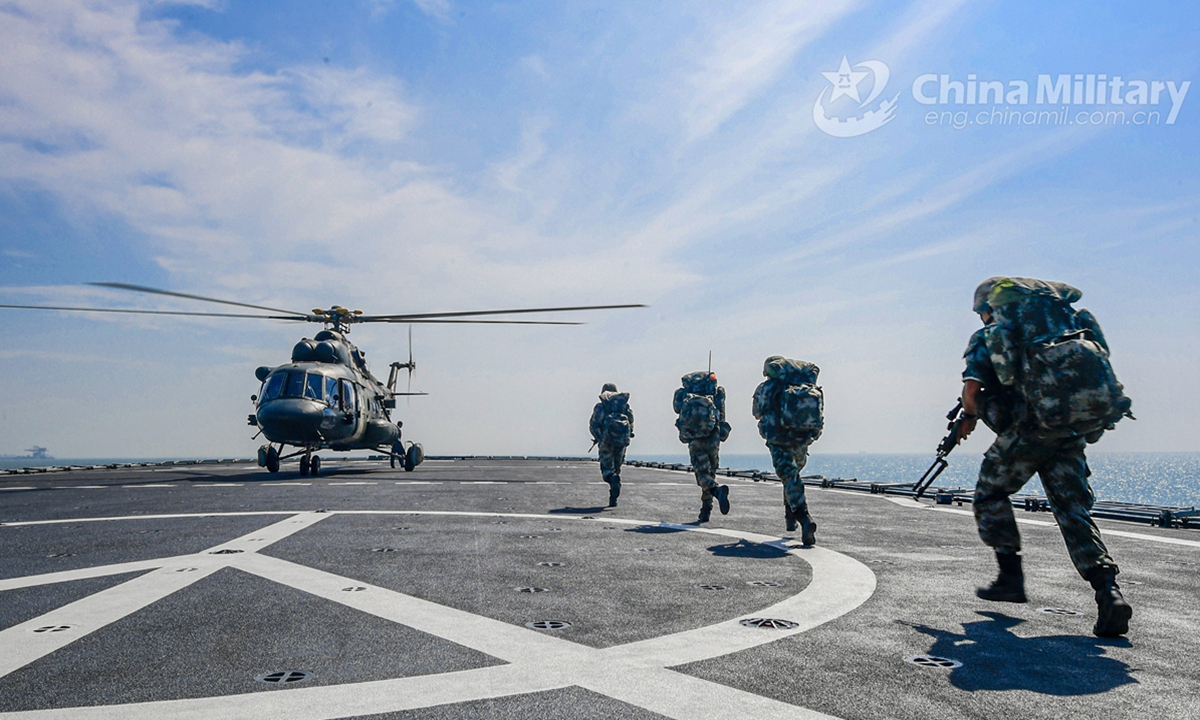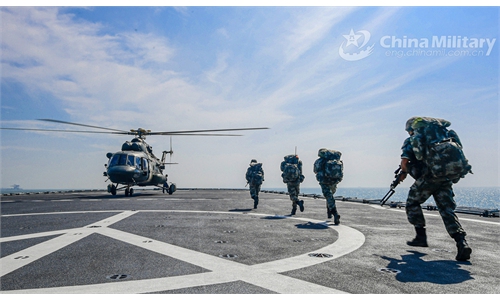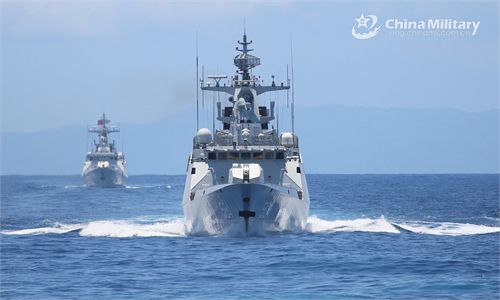
Two fighter jets attached to a naval aviation brigade under the PLA Eastern Theater Command fly in line-abreast formation above the clouds during a recent flight training exercise in East China's Zhejiang Province. (eng.chinamil.com.cn/Photo by Liu Yaxun)
Amid US Undersecretary of State Keith Krach's visit to the island of Taiwan, the Chinese People's Liberation Army (PLA) is holding joint maritime and aerial exercises and combat-readiness patrols in the Taiwan Straits starting Friday, as media on the Taiwan island reported concentrated PLA warplane activities near the island's "airspace" in four directions around the island on Friday morning.
Starting Friday, the PLA Eastern Theater Command is conducting real combat-oriented exercises near Taiwan Straits, Senior Colonel Ren Guoqiang, spokesperson at the Ministry of National Defense, told the Global Times at a press conference on Friday.
The PLA operations have multiple dimensions that make secessionists on the island a turtle in a jar, and the PLA can turn the exercises into real action any time if Taiwan secessionists insist on their obduracy, Chinese mainland experts said on Friday.
The move, which targets the current cross-Straits situation, is legitimate and necessary action the mainland has taken to protect its sovereignty and integrity, Ren said.
The news on the PLA's live-fire exercises came when US Undersecretary of State Keith Krach is paying a visit to Taiwan island to attend the memorial service of Lee Teng-hui, known as the "Godfather of Taiwan secessionism."
Recently, the US has ramped up efforts in playing the Taiwan card and escalated provocations on military and diplomacy - sending reconnaissance planes across the Taiwan Straits, sending senior officials to visit Taiwan and intending to expand arm sales to the island.
Combat-orientated exercises
Chinese mainland military expert Song Zhongping told the Global Times on Friday that the mainland military spokespersons used three different expressions in describing the operations, namely real combat-oriented exercises, combat-readiness patrols and joint aerial and maritime drills, which showed the exercises this time are multidimensional.
Taiwan media cited the island's defense authority as saying 18 PLA warplanes - two H-6 bombers, eight J-16 fighter jets, four J-11 and four J-10 planes - were involved in the operation, and some of them crossed the "middle line" of the Taiwan Straits.
The real combat-oriented, joint aerial and maritime drills mean that the PLA is practicing in key areas of a real battle, while the combat-readiness patrols are operations aimed at preparing for combat anytime if anomalies occur on the island, Song said.
The drills also demonstrated the PLA's strong capability to mobilize for combat and a fast reaction when missions are called for, a Beijing-based military expert who asked not to be identified told the Global Times on Friday.

File Photo:China Military
When US Health and Human Services Secretary Alex Azar visited Taiwan on August 10, in addition to PLA fighter jet sorties on that day, the PLA announced drills in the Taiwan Straits on August 13. When US Undersecretary of State Keith Krach came to visit Taiwan on Thursday, the PLA immediately started real combat-oriented drills the next day.
These have shown that the PLA are well-prepared to deal with any situation in the Taiwan Straits, including mobilizing for a large-scale military operation on the island of Taiwan, in a very short period of time, the anonymous expert said.
Main battle forces of the PLA are always ready to join combat, and the recent drills have tested it, the expert said, noting that this also showed the US forces will not have time to come to Taiwan's aid, and the military on the island would not be able to stand up to the PLA's lightning quick, thundering powerful attacks, if a reunification-by-force operation is to occur.
According to computer simulations run and published by the Chinese mainland's Naval and Merchant Ships magazine in May, as well as many other military analysts, the PLA could launch intensive waves of missile and rocket attacks that would neutralize most of Taiwan's air defense capabilities and airfields within five minutes after the operation starts, and PLA warplanes would then seize air superiority and sweep enemies, with PLA warships, including two aircraft carriers, also engaging in naval battles. General air and sea superiorities are expected to be gained in about two hours, with most stationary ground military facilities destroyed.
Two PLA aircraft carriers would then group up to the east of the island and prepare to counter foreign intervention, and after 24 hours of continuous suppressive attacks, amphibious landing forces would start the landing operation that would eventually see the entire island under control, according to the simulations.
Media on the Taiwan island reported early on Friday that a large number of PLA warplanes were spotted in the "airspace" of Taiwan in four different directions, namely southwest, west, north and northwest, at altitudes ranging from 5,700 meters to 8,400 meters, within just one hour on Friday morning.
The report claimed that the military on the island attempted to use radio broadcast to drive away the PLA aircraft, and according to the broadcast, the PLA operations approached Taiwan's "airspace," instead of "air zone" or "air defense identification zone" that include regions farther away from the island.
This means the PLA has the capability to attack the secessionists on the island from multiple directions at the same time, making them "turtles in a jar" that are easy to catch, Chinese mainland observers said.
Not only in these four directions, the PLA should also surround Taiwan from its east, Song said, noting that this training showed the PLA is practicing realist tactics that can be turned into the real thing when necessary.
Taiwan is a part of China, and the PLA has the right to approach its "airspace," Song stressed.
Some military observers said that by normalizing large-scale exercises, the PLA can assemble troops near Taiwan and launch a sudden attack during the exercises. But Song said that while the PLA has that capability, it will likely not use this method, but rather give an ultimatum to the Taiwan secessionists before doing it.
If the secessionists insist on their obduracy, then the PLA could turn the exercises into real actions and reunify the island, Song said, noting that the PLA is a force of peace, and will only use military means to solve the "Taiwan question" when all other approaches have failed.
In early September, both the PLA's two aircraft carriers were spotted carrying out training exercises out in the sea for the first time, leading to fears on the Taiwan island that the PLA could conduct island encirclement patrols with the aircraft carriers. Two aircraft carriers could be used to squeeze the island of Taiwan from different angles, and deny any possible US intervention, mainland analysts said.
China's second aircraft carrier, the Shandong, is reportedly conducting training missions in the Bohai Sea, and has stayed in the Dalian Shipyard in Northeast China for the majority of this year. When it eventually returns to its home port in Sanya, South China's Hainan Province, it will likely pass through the Taiwan Straits again, observers said.
Citing satellite photos released by the US-based Center for Strategic and International Studies, The Washington Post reported on Wednesday that China's third, larger and more advanced aircraft carrier is taking shape and expected to be launched into the water in the coming months.
If it comes to using military means to solve the Taiwan question, the more aircraft carriers the PLA has, the better. Indeed, three aircraft carriers would result in a significant capability boost to deter possible foreign intervention, Song said.
Some people say the PLA is mighty enough to reunify the island without aircraft carriers, not to mention a third one, but Song said that the PLA should use this overkill capability so as to finish the mission at the lowest cost possible.
"There is no middle line of the Straits," PLA pilots responded when flying across the so-called "middle line of the Taiwan Straits" on Thursday as the island's military called them to turn around, Taiwan media reported on Friday.



